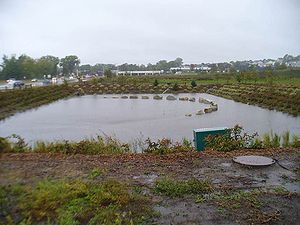
Iron enhanced sand filter (Minnesota Filter)

Iron-enhanced sand filters are filtration Best Management Practices (BMPs) that incorporate filtration media mixed with iron. The iron removes several dissolved constituents, including phosphate, from stormwater. Iron-enhanced sand filters may be particularly useful for achieving low phosphorus levels needed to improve nutrient impaired waters. Iron-enhanced sand filters could potentially include a wide range of filtration BMPs with the addition of iron; however, iron is not appropriate for all filtration practices due to the potential for iron loss or plugging in low oxygen or persistently inundated filtration practices.
Acknowledgements for iron enhanced sand filters
- The articles comprising the Iron enhanced sand filter section have been compiled into a pdf document. To access the pdf, link to: File:Iron enhanced sand filter.pdf
- The individual articles comprising this section on iron enhanced sand filter trench may be viewed as a single article. Note: Due to an unresolved bug, when viewing a formula in a combined article, the math markup (used for equations) is displayed. Please ignore the markup. Thanks.
Iron enhanced sand filter
- Overview for iron enhanced sand filter
- Types of iron enhanced sand filter
- Design criteria for iron enhanced sand filter
- Assessing the performance of iron enhanced sand filter
- Operation and maintenance of iron enhanced sand filter
- Calculating credits for iron enhanced sand filter
- References for iron enhanced sand filter
- Supporting material for iron enhanced sand filter
- Sand filter photos
- Sand filter schematics
- Sand filter tables
Do's and Don'ts of Iron Enhanced Sand Filters (IESFs)
Link to this table
| Don't | Do | Comments |
|---|---|---|
| Don’t assume iron is pure or harmless. | Request mineral analysis of iron-based material. |
|
| Don’t assume iron is reactive with phosphate. | Expose iron material to a solution of soluble phosphate and measure adsorption (e.g., batch studies). | |
| Don’t undersize the IESF for the contributing drainage area. | Design the IESF with the appropriate size and dimensions for the contributing area. | Undersized IESFs will run out of sorption capacity quickly. |
| Don’t install an IESF in areas that become inundated. | Select locations for IESF that receive intermittent flow, adequately dry out between rainfall events, and such that the outlet is above the downstream high-water level | |
| Don’t install IESF where the contributing area lacks phosphate in the runoff. | Measure the phosphate concentration in the runoff where the IESF is intended to be installed. | IESF are most cost-effective when the influent phosphate concentration is > 0.1 mg/L. |
| Don’t specify too much or too little iron in the IESF media mix. | Design IESF with the appropriate amount of iron | IESFs are most efficient and successful when the iron content is between 3% and 8% iron by weight. Using > 8% iron by weight can result in iron solidification and reduced hydraulic and sorption capacity. |
| If mixing with a roto-tiller, don’t assume that the media is well mixed by appearance. | If mixing by roto-tiller, mix, mix, and mix 3 to 4 times the appearance of a well-mixed media. | |
| Don’t ignore inspection and maintenance! | Inspect and maintain IESFs. | Recommended Inspection and maintenance of IESF includes:
|
| Recommended links | ||
- Excel spreadsheet with site information - File:IESF Database FINAL 20190630.xlsx
This page was last edited on 28 December 2022, at 19:02.

